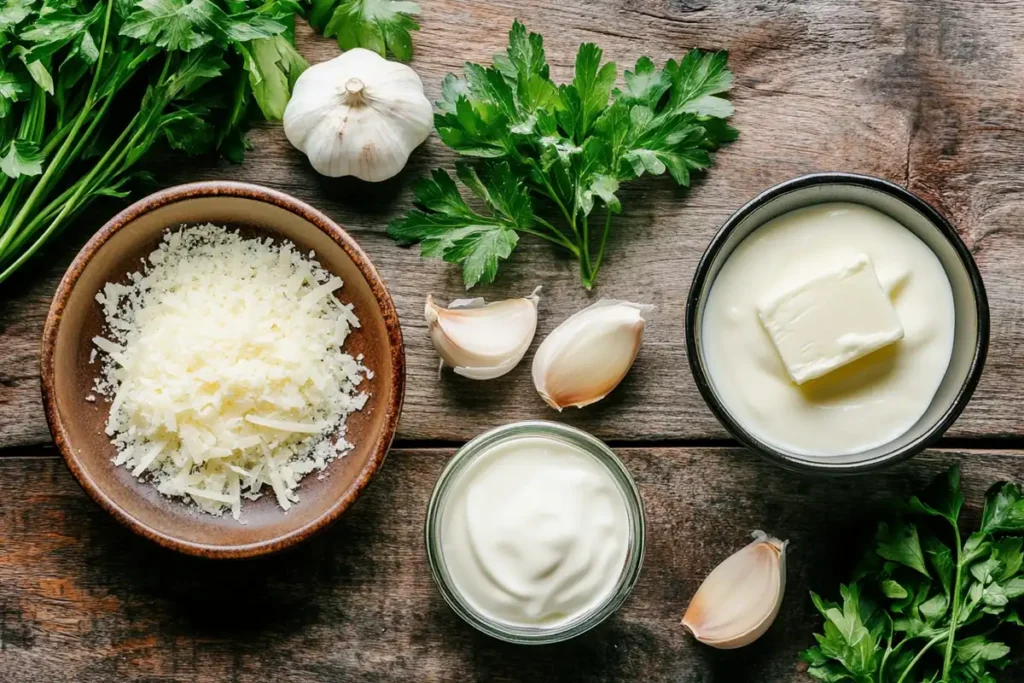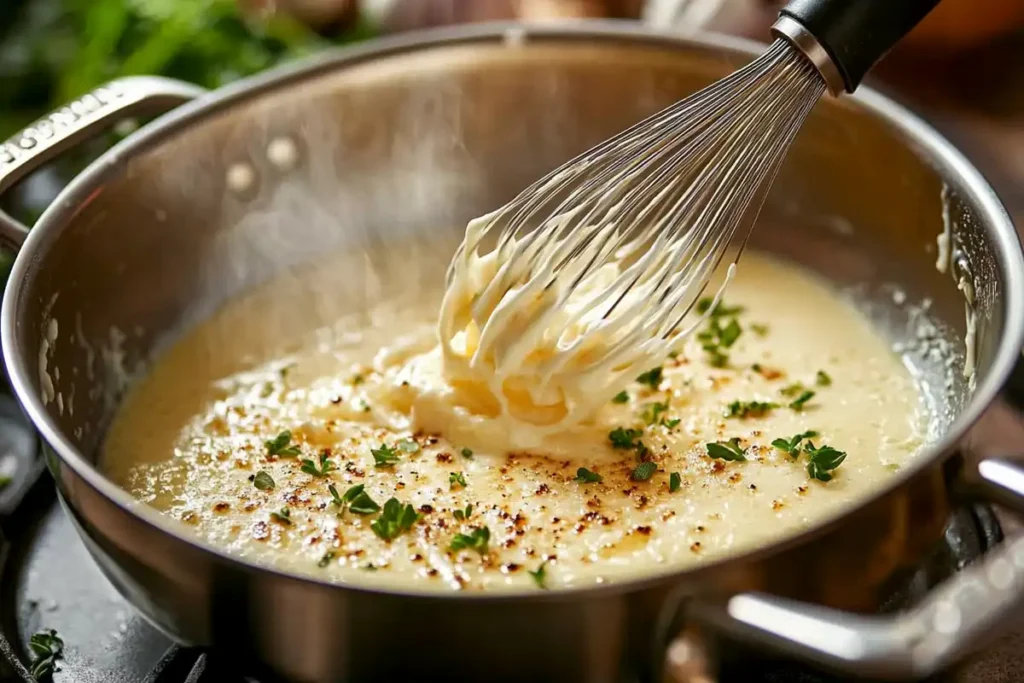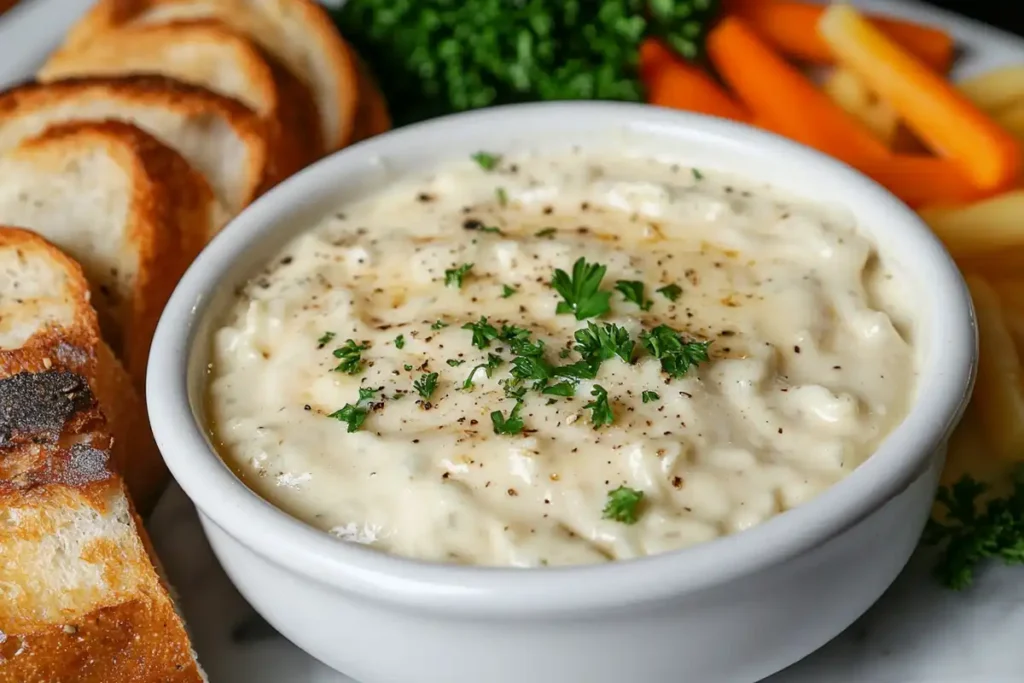If you’re looking to elevate your dishes with a rich and flavorful touch, a Parmesan sauce recipe is the ultimate solution. Whether you’re dressing up pasta, drizzling over roasted veggies, or using it as a dip, this creamy sauce promises to delight your taste buds. This guide walks you through every step — from understanding its roots and essential ingredients to perfecting the cooking process. With clear instructions and practical tips, you’ll master the art of making this decadent sauce in no time. Let’s dive into the creamy world of Parmesan!
Understanding Parmesan Sauce
What Is Parmesan Sauce?
Parmesan sauce is a creamy, cheese-based sauce often used to add a luxurious, velvety texture and bold flavor to dishes. Made from Parmesan cheese, butter, and cream, it’s known for its silky consistency and nutty undertones. Unlike other cheese sauces, it’s versatile, pairing beautifully with pasta, chicken, seafood, and even vegetables.
This sauce can range from simple and mild to rich and complex, depending on the ingredients you incorporate. By learning how to craft it, you can elevate everyday meals into gourmet creations.
History and Origin of Parmesan Sauce
While the exact origin of Parmesan sauce isn’t well-documented, its key ingredient, Parmesan cheese, hails from Italy’s Emilia-Romagna region. Known as Parmigiano Reggiano, this cheese has been a culinary staple for centuries. The tradition of creating creamy sauces from aged cheeses dates back to Italian Renaissance kitchens, where chefs used them to enhance pasta and bread dishes.
Over time, this sauce gained global popularity, transforming into an adaptable recipe loved by home cooks and professional chefs alike.
Ingredients and Equipment
Essential Ingredients for Parmesan Sauce

Crafting the perfect Parmesan sauce starts with gathering high-quality ingredients. While the recipe itself is straightforward, using fresh and authentic components can make all the difference in taste and texture.
Primary Components
These ingredients form the backbone of the sauce and are non-negotiable for achieving its signature flavor and consistency:
- Parmesan Cheese: The star of the show! Opt for freshly grated Parmigiano Reggiano for a bold, nutty flavor. Pre-grated versions can contain anti-caking agents, which may hinder smooth melting.
- Heavy Cream: The key to a silky and rich sauce, heavy cream ensures the right thickness and creamy consistency.
- Butter: Adds a luscious depth to the sauce and helps blend the flavors seamlessly.
Optional Additions
Want to customize your sauce? These additions can take your recipe from classic to extraordinary:
- Garlic: A pinch of minced garlic creates a subtle aroma and depth that complements the cheese.
- Herbs and Spices: Fresh parsley, a sprinkle of nutmeg, or cracked black pepper can elevate the flavor profile.
- Lemon Zest: Adds a touch of brightness and balances the richness of the cream.
Necessary Kitchen Equipment
To ensure your Parmesan sauce turns out smooth and lump-free, the right tools are essential:
- Saucepan: A medium-sized, heavy-bottomed saucepan helps distribute heat evenly, preventing scorching.
- Whisk: A whisk is vital for blending the ingredients and achieving a creamy consistency.
- Measuring Tools: Precise measurements ensure consistent results every time.
By preparing these ingredients and tools ahead of time, you set the stage for success.
Step-by-Step Preparation
Preparing the Ingredients
Before you start cooking, it’s crucial to have your ingredients prepped and ready. This ensures a smooth cooking process and a lump-free Parmesan sauce.
Grating the Parmesan Cheese
Freshly grated Parmesan cheese is key to achieving a smooth, creamy texture. Here’s how to do it:
- Use a fine grater or microplane to shred the cheese finely. Smaller shreds melt more easily into the sauce.
- Avoid using pre-grated Parmesan as it often contains anti-caking agents, which can cause clumps.
Measuring the Liquids
Precision matters when working with cream and butter. Measure out:
- 1 cup of heavy cream for a thick consistency.
- 2 tablespoons of butter to enhance the sauce’s richness.
Cooking the Sauce

Now that your ingredients are prepared, it’s time to bring them together in a saucepan. Follow these steps for a flawless sauce:
Melting the Butter
- Place your saucepan over low heat.
- Add the butter and let it melt completely, stirring occasionally to prevent browning. The goal here is to create a smooth base for the sauce.
Adding the Cream
- Slowly pour in the heavy cream while whisking continuously. This ensures the butter and cream blend seamlessly without separating.
- Heat the mixture gently, avoiding boiling, as high heat can cause curdling.
Incorporating the Parmesan Cheese
- Gradually sprinkle in the grated Parmesan cheese, whisking as you go. This prevents clumping and ensures a silky texture.
- Continue stirring over low heat until the cheese has melted completely into the cream.
Seasoning the Sauce
- Add salt sparingly since Parmesan cheese is naturally salty.
- Sprinkle in black pepper or nutmeg for added depth. If desired, toss in minced garlic or fresh parsley for extra flavor.
Tips for Perfect Parmesan Sauce
- Use low to medium heat to avoid burning or curdling.
- If the sauce becomes too thick, stir in a splash of milk or cream to adjust the consistency.
- Whisk constantly to prevent lumps from forming.
With your Parmesan sauce prepared to perfection, it’s ready to complement a variety of dishes. But how do you make the most of it? In the next part, we’ll explore the best ways to serve and pair this delightful sauce!
Serving and Pairing Parmesan Sauce
How to Use Parmesan Sauce

A creamy Parmesan sauce is incredibly versatile, making it a must-have in any kitchen. Whether you’re preparing a cozy family dinner or an elegant meal for guests, this sauce can elevate a range of dishes.
Pasta Dishes
Parmesan sauce is the ideal companion for pasta. Its velvety texture clings perfectly to spaghetti, fettuccine, or penne. For a classic touch, toss it with fettuccine to create a quick and easy Alfredo-inspired dish. Want a lighter option? Mix it with zucchini noodles for a low-carb twist.
Vegetable Enhancements
Roasted vegetables, like broccoli, cauliflower, or asparagus, become irresistible with a drizzle of this creamy sauce. You can also use it as a dip for steamed vegetables, turning a simple side dish into a star attraction.
Protein Pairings
Pair your Parmesan sauce with grilled chicken, shrimp, or pan-seared salmon for a delightful main course. The sauce adds moisture and richness, perfectly balancing lean proteins with its creamy texture.
Appetizers and Snacks
From crispy garlic bread to stuffed mushrooms, Parmesan sauce works wonders as a dipping sauce. It also pairs well with fried snacks like mozzarella sticks or chicken tenders.
Tips for Serving Parmesan Sauce
- Serve the sauce immediately after preparation for the best texture and flavor. Reheating can alter the consistency.
- If preparing ahead, store it in an airtight container in the refrigerator and reheat gently over low heat, adding a splash of cream to restore its smoothness.
- Garnish with freshly chopped parsley or a sprinkle of Parmesan cheese for a professional finish.
Creative Variations
Experiment with your Parmesan sauce by customizing it to suit different cuisines or preferences:
- Spicy Kick: Add a pinch of red pepper flakes for a hint of heat.
- Garlic Lovers: Double the garlic for an extra burst of flavor.
- Herbal Infusion: Blend in fresh basil, thyme, or oregano for a Mediterranean twist.
With your sauce ready and served, it’s time to dive into troubleshooting and perfecting the texture, ensuring every batch is just as smooth as the last. Up next, we’ll discuss common issues and how to avoid them. Stay tuned!
Troubleshooting Parmesan Sauce
Even seasoned cooks can run into issues while making Parmesan sauce. Understanding common problems and their solutions will ensure you achieve a flawless sauce every time. Let’s tackle the challenges head-on and keep your sauce smooth and creamy!
Why Does Parmesan Sauce Clump?
Clumping is a frequent issue when making cheese-based sauces. Here’s why it happens and how to fix it:
- Using Pre-Grated Cheese: Anti-caking agents in pre-grated Parmesan prevent smooth melting. Always opt for freshly grated cheese.
- Adding Cheese Too Quickly: Dumping in all the cheese at once overwhelms the sauce. Gradually sprinkle the cheese while whisking.
- High Heat: Overheating the sauce can cause the cheese to seize and clump. Use low to medium heat for a gentle melt.
How to Prevent a Thin or Watery Sauce
Nobody likes a runny sauce, but fixing this problem is simple:
- Solution: Simmer the sauce a little longer. The heat will reduce the liquid, creating a thicker consistency.
- Tip: If your sauce is still too thin, mix 1 teaspoon of cornstarch with a tablespoon of cold cream or milk. Slowly stir this slurry into the sauce and heat until it thickens.
What If the Sauce Separates?
Separation occurs when the fat from the butter or cream splits from the other ingredients. Here’s how to salvage it:
- Cause: This often happens due to excessive heat or improper mixing.
- Fix: Remove the sauce from the heat immediately and whisk vigorously. Adding a splash of warm cream can help re-emulsify the sauce.
How Do You Store Leftover Parmesan Sauce?
Storing Parmesan sauce properly keeps it fresh and ready for another meal:
- Allow the sauce to cool completely before transferring it to an airtight container.
- Refrigerate for up to 3 days. For longer storage, freezing is an option, though the texture may change slightly upon thawing.
Reheating Tips
When reheating, avoid using high heat, which can cause the sauce to break:
- Heat gently in a saucepan over low heat, stirring constantly.
- Add a small amount of milk or cream to loosen the sauce if it feels too thick.
By knowing how to handle these challenges, you’ll be able to troubleshoot any issues and enjoy a perfect sauce every time. Up next, we’ll dive into FAQs to address some of the most common questions about Parmesan sauce recipes. Let’s clear up those lingering doubts!
Frequently Asked Questions About Parmesan Sauce Recipe
To help you master the art of making Parmesan sauce, here are detailed answers to some of the most commonly asked questions. Whether you’re a beginner or an experienced cook, these insights will address your concerns and guide you toward perfecting this creamy delight.
What is Parmesan sauce made of?
Parmesan sauce is typically made from simple ingredients: freshly grated Parmesan cheese, heavy cream, butter, and optional seasonings like garlic, nutmeg, or herbs. These ingredients blend together to create a rich, velvety sauce that enhances various dishes. High-quality Parmesan cheese is essential, as it imparts the sauce’s signature nutty and savory flavor.
What’s the difference between Alfredo sauce and garlic Parmesan sauce?
While both are creamy and cheese-based sauces, there are key differences:
- Alfredo Sauce: Traditionally made with butter, cream, and Parmesan cheese, Alfredo sauce has a simpler, more delicate flavor.
- Garlic Parmesan Sauce: This version includes garlic, which adds a robust and aromatic flavor to the sauce. It’s a heartier option often used for dipping or drizzling over proteins like chicken or seafood.
What is Domino’s garlic Parmesan sauce made of?
Domino’s garlic Parmesan sauce is a commercial variation of Parmesan sauce. It typically includes butter, cream, Parmesan cheese, garlic, and additional flavor enhancers like onions, herbs, and spices. While delicious, it may contain preservatives and other additives for shelf stability, making homemade Parmesan sauce a fresher and healthier alternative.
How do you make Parmesan not clump in sauce?
Clumping can be avoided with these simple techniques:
- Use freshly grated Parmesan cheese to ensure it melts smoothly.
- Add the cheese gradually to the sauce, whisking continuously.
- Keep the heat low to prevent the cheese from overheating and seizing.
These steps will help you achieve a silky texture without lumps or graininess.
Additional Tips for Perfect Parmesan Sauce
- Always whisk continuously while cooking to keep the ingredients well-combined.
- For a lighter version, you can substitute half-and-half for heavy cream, though the sauce may be less rich.
- Experiment with seasonings and garnishes, such as red pepper flakes or fresh parsley, to tailor the sauce to your preferences.
With these FAQs answered, you now have the confidence to make a flawless Parmesan sauce recipe. In the final section, we’ll wrap up with a quick recap and serving ideas to inspire your next culinary creation. Stay tuned!
Wrapping Up and Final Thoughts
Congratulations! You’ve explored the ins and outs of crafting the perfect Parmesan sauce recipe, from understanding its origins to mastering the preparation process. Let’s bring it all together with some final insights and inspiration to help you put this creamy creation to delicious use.
Why Parmesan Sauce Is a Kitchen Staple
The versatility of Parmesan sauce makes it an essential recipe for home cooks and culinary enthusiasts alike. Its rich, nutty flavor and smooth texture can elevate any meal, whether it’s a simple weeknight dinner or an elaborate feast. With minimal ingredients and easy steps, this sauce is accessible to everyone — and it’s endlessly customizable to suit your preferences.
Creative Serving Ideas
Need inspiration for using your freshly made Parmesan sauce? Here are some unique and flavorful ideas:
- Pizza Topping: Swap out tomato sauce for Parmesan sauce as a base for a creamy white pizza.
- Lasagna Layer: Add a layer of Parmesan sauce to lasagna for a richer, cheesier flavor.
- Stuffed Vegetables: Spoon the sauce over stuffed bell peppers or zucchini for a gourmet touch.
- Breakfast Boost: Drizzle over scrambled eggs or a breakfast casserole for a decadent start to your day.
Encouragement to Experiment
The beauty of Parmesan sauce lies in its adaptability. Don’t be afraid to experiment with additional ingredients or techniques to make it your own. Whether you prefer a touch of garlic, a hint of spice, or a blend of fresh herbs, the possibilities are endless.
Storing and Sharing the Recipe
Now that you’ve perfected your recipe, why not share it with family and friends? Store extra sauce in the fridge or freezer, and pair it with a variety of dishes to impress at gatherings. Homemade Parmesan sauce is not only delicious but also a thoughtful gift when packaged in a decorative jar.

